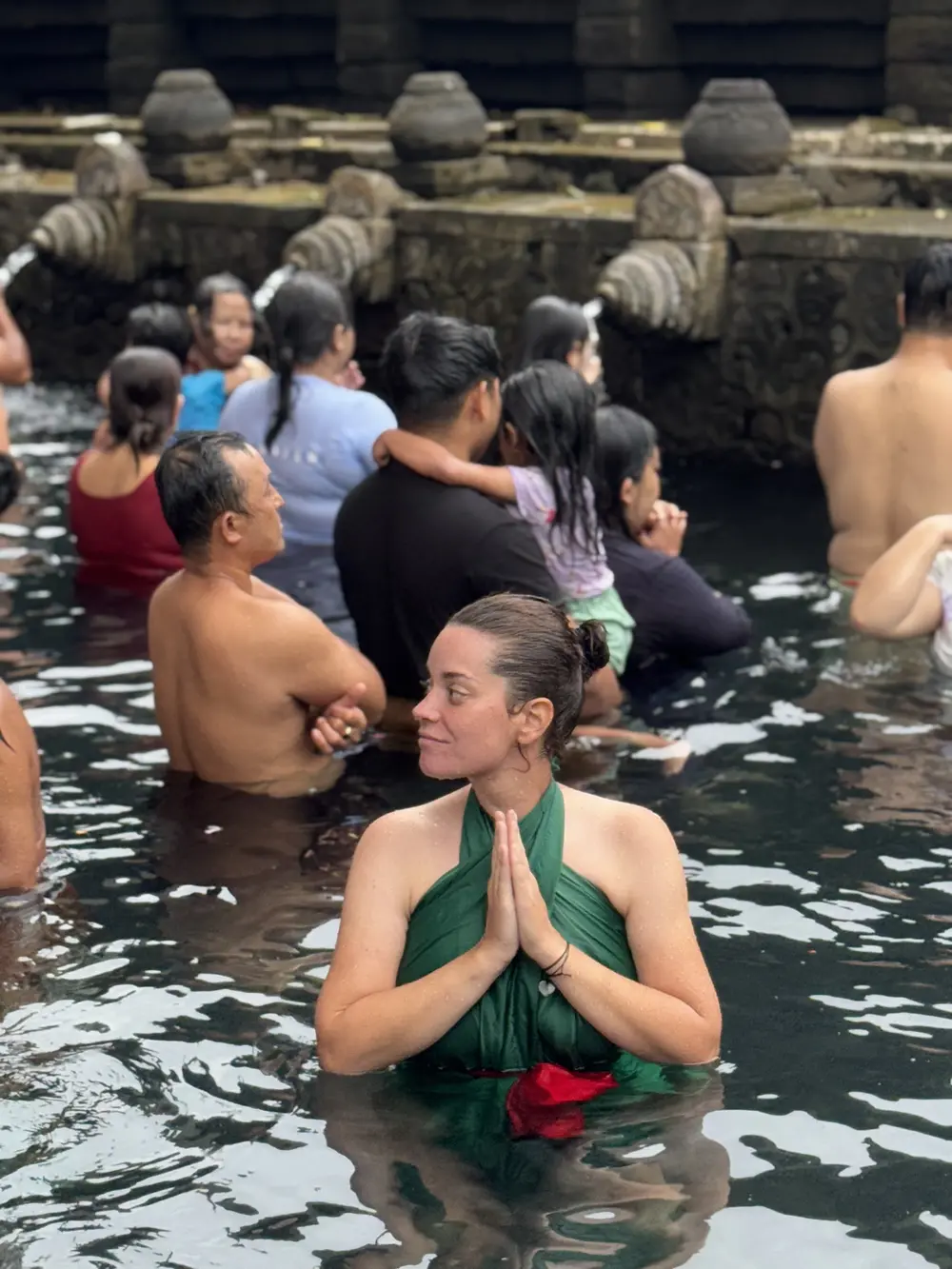Tirta Empul Temple is one of Bali’s most sacred Hindu temples, known for its holy spring water believed to have powerful cleansing energy. The name Tirta Empul means “holy spring,” symbolizing purity and spirituality. Visitors from around the world come to join the melukat ritual, a traditional cleansing ceremony where they bathe under flowing water to purify the mind, body, and soul. Surrounded by green hills and traditional Balinese design, the temple’s peaceful setting, ancient stone carvings, and clear pools create a serene atmosphere, making it one of Bali’s most beautiful and meaningful cultural landmarks.
Where is Tirta Empul Temple in Bali
Tirta Empul Temple is located in the village of Manukaya, near the town of Tampaksiring in Central Bali. It lies about 30 minutes north of Ubud, making it a popular stop for travelers exploring the cultural heart of the island. The temple sits at the foot of a green hillside, close to the presidential palace built during Indonesia’s first presidency.
Its location is easy to reach by car or scooter, and many visitors include it in their Bali private tours or day trips from Ubud. The route to the temple passes through picturesque rice terraces, small Balinese villages, and local markets, giving travelers a glimpse of authentic rural life.
Because of its peaceful surroundings and spiritual significance, Tirta Empul is often considered a must-visit destination for anyone wanting to experience Bali’s deep cultural and religious traditions.
How Old is Tirta Empul ?

Tirta Empul Temple dates back to 962 AD, during the Warmadewa Dynasty. This makes it more than one thousand years old. Despite its age, the temple has been remarkably well-preserved and continues to serve as a vital place of worship for Balinese Hindus.
The temple’s long history reflects Bali’s enduring spiritual traditions and the importance of water in Balinese culture. Water is not only used for daily life but also represents purification, fertility, and the balance between human and divine forces. The sacred spring at Tirta Empul has never stopped flowing, and it is still used today for religious ceremonies and blessings.
When you walk through the temple complex, you can sense the ancient energy that has been flowing through this site for centuries. The moss-covered stones and traditional shrines tell the story of generations who have come here seeking purification and connection with the divine.
Tirta Empul Temple Tour
Customizable Ubud Day Trip – Explore Your Way
Bali VW tour (Ubud) | Volkswagen Safari Classic Car Tours
We offer two unique ways to visit Tirta Empul Temple as part of your Ubud experience.
The first is our Ubud VW Tour, a fun trip around Ubud using a classic Volkswagen car. You’ll explore scenic rice terraces, traditional villages, and finally visit the sacred Tirta Empul Temple. The open-roof VW adds a vintage touch, letting you enjoy the fresh air and beautiful views along the way.
The second option is our Ubud Day Trip, perfect for travelers who want flexibility. You can create your own itinerary, combining Tirta Empul Temple with other attractions like coffee plantations, art markets, or waterfalls.
Both tours include private transport, friendly English-speaking drivers, and plenty of time to explore the temple or join the purification ritual. A Tirta Empul Temple tour with us is not just sightseeing, but a meaningful journey into Balinese culture and spirituality.
History of Tirta Empul Temple
The legend behind Tirta Empul Temple is deeply rooted in Balinese mythology. According to local belief, the sacred spring was created by the god Indra. The story tells that Indra and his army fought against a powerful but evil king named Mayadenawa, who refused to allow his people to worship the gods. During the battle, Mayadenawa poisoned the water sources, causing illness and suffering.
In response, Indra struck the ground with his staff, and from that spot, a clear spring burst forth, restoring health to his soldiers. That spring became known as Tirta Empul, the holy water that still flows today.
Over the centuries, the temple was built around the spring to honor Indra and the divine gift of purification. The architecture of Tirta Empul reflects a blend of ancient Balinese design and Hindu symbolism. Every stone, statue, and carving tells a story of devotion and the balance between good and evil.
In modern times, the temple continues to play an important role in the spiritual life of the Balinese people. Ceremonies, offerings, and festivals are held regularly, especially during major Hindu holidays such as Galungan and Kuningan.
The Indonesian government has also recognized Tirta Empul as a national heritage site, ensuring its preservation for future generations.
Dress Code for Tirta Empul Temple
When visiting Tirta Empul Temple, dressing respectfully is essential. The Balinese take temple etiquette seriously, and visitors are expected to follow traditional customs.
All visitors must wear a sarong and a sash before entering the temple complex. These can be rented or borrowed at the entrance for a small donation. A sarong is a long piece of cloth wrapped around the waist, while the sash is tied around the waist as a symbol of respect.
Both men and women should ensure their shoulders and knees are covered. Avoid wearing revealing or tight clothing. If you plan to participate in the purification ritual, bring an extra set of clothes or swimwear to wear under the sarong, as you will get wet in the pools.
It’s also important to note that visitors who are menstruating are traditionally not allowed to enter Balinese temples, as it is considered a time of spiritual impurity.
By following these guidelines, you not only show respect for Balinese culture but also contribute to the preservation of the temple’s sacred atmosphere.
Tirta Empul Temple Entrance Fee
As of recent updates, the entrance fee for Tirta Empul Temple is around IDR 50,000 for adults and IDR 25,000 for children. This fee helps support the maintenance and preservation of the temple.
There is an additional small charge if you wish to rent a sarong or participate in the purification ritual. Local guides are available at the entrance for those who want to learn more about the temple’s history and traditions.
The temple is open daily from around 8 a.m. to 6 p.m., but it’s best to visit early in the morning to avoid crowds and enjoy a more peaceful experience.
Parking is available near the entrance, and local vendors sell drinks, snacks, and souvenirs. Many visitors combine a trip to Tirta Empul with nearby sites, making it a full-day cultural tour around the Ubud and Tampaksiring area.
Conclusion
Tirta Empul Temple is more than just a tourist destination. It is a living spiritual site where ancient traditions meet the daily lives of modern Balinese people. The sound of flowing water, the scent of incense, and the sight of people praying create a sense of peace that lingers long after you leave.
Whether you come for a spiritual cleansing, a cultural experience, or simply to admire its beauty, Tirta Empul will leave you with a deeper understanding of Bali’s soul.
Frequently Asked Questions
Is the water at Tirta Empul clean?
Yes, the water at Tirta Empul is naturally clean and comes from a sacred underground spring. It is constantly flowing, which keeps it fresh and clear. Locals and visitors use it for purification rituals, and the temple staff maintain the area regularly to ensure cleanliness.
Why is the Tirta Empul important?
Tirta Empul is important because it represents purification and spiritual renewal in Balinese Hinduism. The temple’s holy spring is believed to have divine powers created by the god Indra, making it one of the most sacred places in Bali.
Who is the deity of Tirta Empul Temple?
The main deity of Tirta Empul Temple is Lord Indra, the god of rain and thunder. According to legend, Indra created the temple’s sacred spring to heal his poisoned soldiers, symbolizing protection and cleansing from negative energy.
Why is the Tirta Empul Temple important?
The temple is a key site for Balinese religious life, where purification rituals are performed daily. It also preserves ancient traditions, art, and architecture that reflect the island’s deep spiritual heritage.
Is it worth visiting Tirta Empul Temple?
Absolutely. Tirta Empul is not only a beautiful temple but also a meaningful cultural and spiritual experience. Visitors can witness or join the holy bathing ritual, admire the architecture, and feel the peaceful atmosphere that makes it one of Bali’s must-visit destinations.
What is the significance of the Tirta Empul Temple?
The temple’s significance lies in its role as a sacred place for purification and prayer. It symbolizes the balance between human and divine energy, and the flowing water represents renewal, healing, and spiritual cleansing.
Are Tirta Gangga and Tirta Empul the same?
No, they are different sites. Tirta Gangga is a former royal water palace in East Bali, known for its ornamental ponds and gardens, while Tirta Empul is a temple in Central Bali famous for its holy spring used in purification rituals.
Are there changing rooms at Tirta Empul?
Yes, there are basic changing rooms available for visitors who wish to participate in the holy bathing ceremony. It is recommended to bring an extra set of clothes or a towel after joining the ritual.





0 Comment